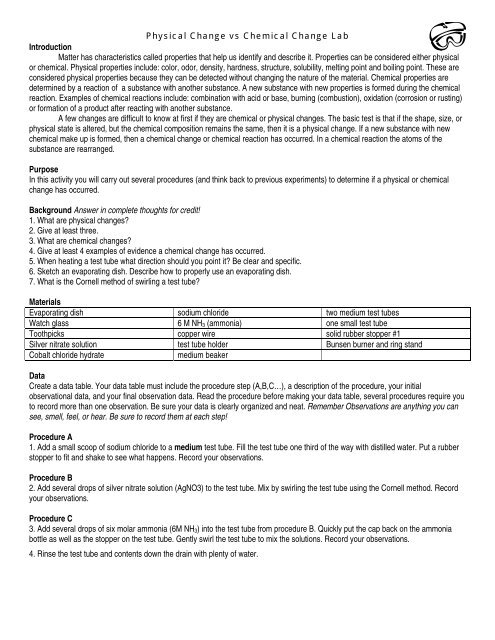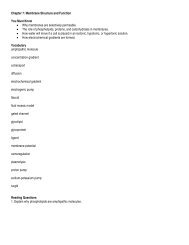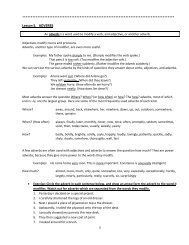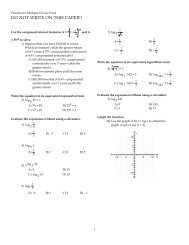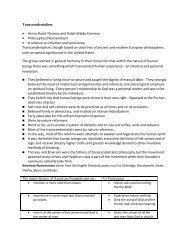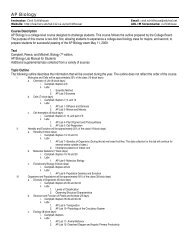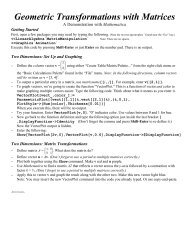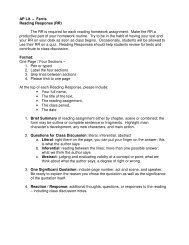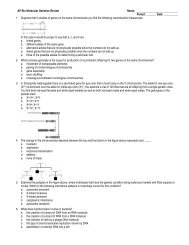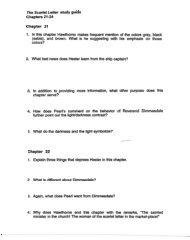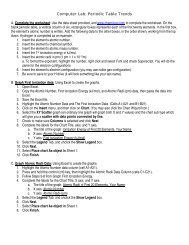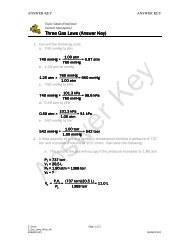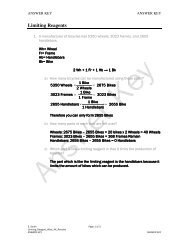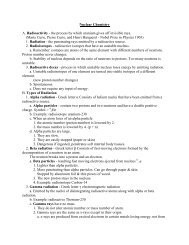Physical Change vs Chemical Change Lab Introduction ... - Teacher
Physical Change vs Chemical Change Lab Introduction ... - Teacher
Physical Change vs Chemical Change Lab Introduction ... - Teacher
You also want an ePaper? Increase the reach of your titles
YUMPU automatically turns print PDFs into web optimized ePapers that Google loves.
<strong>Physical</strong> <strong>Change</strong> <strong>vs</strong> <strong>Chemical</strong> <strong>Change</strong> <strong>Lab</strong><br />
<strong>Introduction</strong><br />
Matter has characteristics called properties that help us identify and describe it. Properties can be considered either physical<br />
or chemical. <strong>Physical</strong> properties include: color, odor, density, hardness, structure, solubility, melting point and boiling point. These are<br />
considered physical properties because they can be detected without changing the nature of the material. <strong>Chemical</strong> properties are<br />
determined by a reaction of a substance with another substance. A new substance with new properties is formed during the chemical<br />
reaction. Examples of chemical reactions include: combination with acid or base, burning (combustion), oxidation (corrosion or rusting)<br />
or formation of a product after reacting with another substance.<br />
A few changes are difficult to know at first if they are chemical or physical changes. The basic test is that if the shape, size, or<br />
physical state is altered, but the chemical composition remains the same, then it is a physical change. If a new substance with new<br />
chemical make up is formed, then a chemical change or chemical reaction has occurred. In a chemical reaction the atoms of the<br />
substance are rearranged.<br />
Purpose<br />
In this activity you will carry out several procedures (and think back to previous experiments) to determine if a physical or chemical<br />
change has occurred.<br />
Background Answer in complete thoughts for credit!<br />
1. What are physical changes?<br />
2. Give at least three.<br />
3. What are chemical changes?<br />
4. Give at least 4 examples of evidence a chemical change has occurred.<br />
5. When heating a test tube what direction should you point it? Be clear and specific.<br />
6. Sketch an evaporating dish. Describe how to properly use an evaporating dish.<br />
7. What is the Cornell method of swirling a test tube?<br />
Materials<br />
Evaporating dish sodium chloride two medium test tubes<br />
Watch glass 6 M NH3 (ammonia) one small test tube<br />
Toothpicks copper wire solid rubber stopper #1<br />
Silver nitrate solution test tube holder Bunsen burner and ring stand<br />
Cobalt chloride hydrate medium beaker<br />
Data<br />
Create a data table. Your data table must include the procedure step (A,B,C…), a description of the procedure, your initial<br />
observational data, and your final observation data. Read the procedure before making your data table, several procedures require you<br />
to record more than one observation. Be sure your data is clearly organized and neat. Remember Observations are anything you can<br />
see, smell, feel, or hear. Be sure to record them at each step!<br />
Procedure A<br />
1. Add a small scoop of sodium chloride to a medium test tube. Fill the test tube one third of the way with distilled water. Put a rubber<br />
stopper to fit and shake to see what happens. Record your observations.<br />
Procedure B<br />
2. Add several drops of silver nitrate solution (AgNO3) to the test tube. Mix by swirling the test tube using the Cornell method. Record<br />
your observations.<br />
Procedure C<br />
3. Add several drops of six molar ammonia (6M NH3) into the test tube from procedure B. Quickly put the cap back on the ammonia<br />
bottle as well as the stopper on the test tube. Gently swirl the test tube to mix the solutions. Record your observations.<br />
4. Rinse the test tube and contents down the drain with plenty of water.
Procedure D<br />
5. Fold up copper wire and place it inside a small test tube. Cover the wire with silver nitrate solution. Set the test tube aside for 10-15<br />
minutes. Record initial observation and record your observations after 10-15 min.<br />
6. Carefully dump the contents of the test tube into the trash (NOT DOWN THE SINK), and clean your test tube.<br />
Procedure E<br />
7. Set up your Bunsen burner and ring stand. Remember to place the evaporating dish on the wire mesh before lighting your Bunsen<br />
burner! Place a small scoop of cobalt chloride hydrate into an evaporating dish. Heat it slowly until it changes color. Record your<br />
observations.<br />
8. Turn off your Bunsen burner and let the dish cool for at least 15 minutes. After the substance has cooled add some water to the solid<br />
and record your observations.<br />
Procedure F<br />
9. Break three toothpicks into small pieces and put them into a medium test tube. You will use an old, stained test tube for this<br />
procedure. Holding the test tube with the test tube holder, SLOWLY heat the test tube until a significant change is observable. Place<br />
your test tube in a medium beaker to cool. You may place your sample in the fume hood if the change is significant.<br />
10. After the test tube has cooled dump the solid water into the trash and clean the test tube.<br />
Procedure G<br />
11. Think back to the Sand and Salt Separation lab. Record what the salt water looked like before you heated it and record what the<br />
sample of salt water looked like after you heated it.<br />
12. After the conclusion of Procedures A-G return your supplies to the lab table. Be sure to wash your hands after returning your<br />
equipment!<br />
Analysis Answer in complete thoughts for credit!<br />
1. Identify the procedures where physical changes occurred. Be sure to describe the elements and compounds used not the letter of<br />
the procedure. Explain how you determined each was a physical change. You may create a data table to answer this question.<br />
2. Identify the procedures where chemical changes occurred. Be sure to describe the elements and compounds used not the letter of<br />
the procedure. Explain how you determined each was a chemical change. You may create a data table to answer this question.<br />
3. If color change could be evidence of both a chemical and physical change how could you determine which type of change were<br />
happening in an experiment?<br />
Conclusion<br />
Summarize physical and chemical changes. Be sure to describe how you can determine if a physical or chemical change has occurred.


